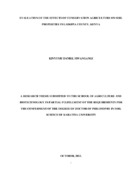| dc.description.abstract | Conservation agriculture (CA), defined by three principles of; minimum soil disturbance, use of cover crop and crop rotation/diversification was introduced in Laikipia as alternative to conventional farming (CF) systems, to improve soil properties and resilience to climate change and soil degradation. The study investigated practice of CA by farmers and carried out in-situ and laboratory analysis of soil moisture, bulk density, texture, soil nitrogen, phosphorus, exchangeable cations and microbial diversity. The study area was purposively selected to include areas where CA had historically been practised. A population of 2,000 farmers registered as practising CA were interviewed. For the collection of soil samples, 332 farmers were sampled based on; (i) farmers who received training on CA curriculum (ii) farmers who were actively practising all the three principles of CA (minimum soil disturbance, crop rotation and soil cover); and (iii) farmers who were practising CA alongside conventional farming. Thirty (30) farmers were sampled according population in each through proportionate stratified random sampling. 270 composite soil samples were collected from 3x3 m plots at a depth of 0-20 cm (rooting zone) of annual crops, from 30 farms, during 2019 and 2020 cropping seasons. Soil sampling for analysis soil bulk density, moisture) while soil sampling for the analysis of chemical and microbial properties was done using core ring sampler of 5cm diameter and 10cm height and metallic soil augers of 5cm diameter, respectively. The analysis of soil physical and chemical properties were done according to protocols in soil and plant analysis and national agricultural research laboratories (NARL) manuals. The analysis of microbial diversity was done according to functional gene analysis pipeline (www.mrdnalab.com). Findings describing significance differences in soil properties between farming systems were done using one-way analysis of variance (ANOVA) at (p ≤ 0.05), followed by post-hoc family-wise comparisons of means between experimental plots. Tukey’s honest significance difference (HSD) tested mean separation when analysis showed statistically significant differences (p < 0.05). The DNA from environmental samples was extracted using PureLinkTM Microbiome DNA Purification Kit (Thermo Fisher Scientific). Amplicon generation and sequencing was done using the next generation (NGS) Illumina’s MiSeq technology platform (bTEFAP)®. All statistical analyses were performed using IBM SPSS ver 22, R-program and MS-Excel for Windows. Findings of CA farming practices indicated that 67% of farmers employed all the three principles of conservation agriculture (crop cover/residue + crop rotation + no tillage). Majority (62%) of farmers were largely subsistence farmers, growing mainly; maize (Zea mays L.) and beans (Phaseolus vulgaris L.). Silt clay loam (SCL) was the most abundant at 60%, while 67.47% of farmers employed all the 3 principles of CA. Farms adopting CA had the highest soil bulk density at 1.78 ±0.04 g/cm3. Soil moisture levels in farms declined significantly from ‘25” to “75” days after seeding (DAS) under different farming systems. Soil carbon was significantly higher in farms adopting CA, which is postulated to be due to the high use of organic biomass on soil. The study found important rhizospheric bacteria and fungi that affects soil properties. The findings can be used for developing a holistic soil improvement strategy for improving soil properties and enhancing farmer resilience to climate change effects in rain-fed farming systems in Laikipia. | en_US |
